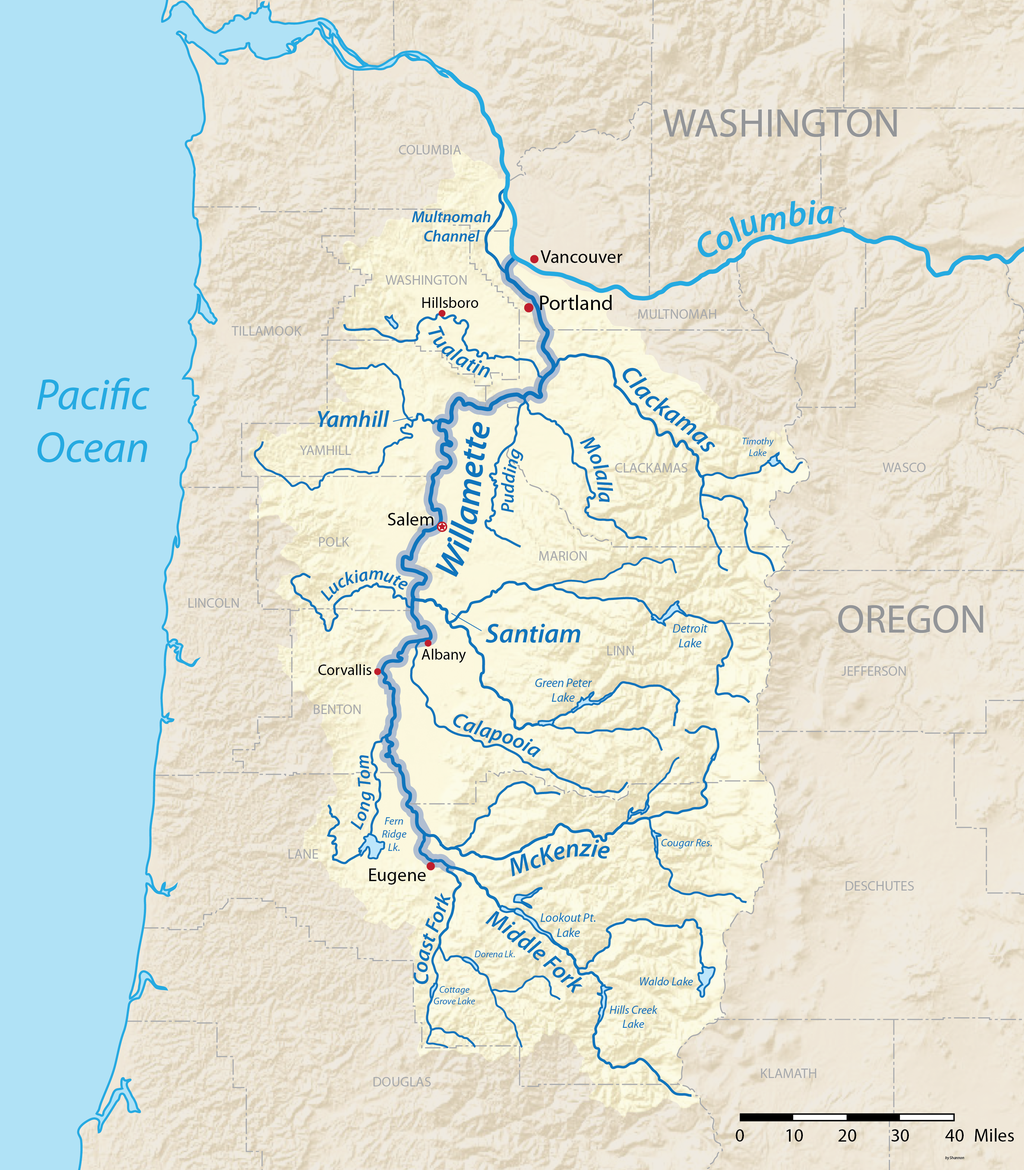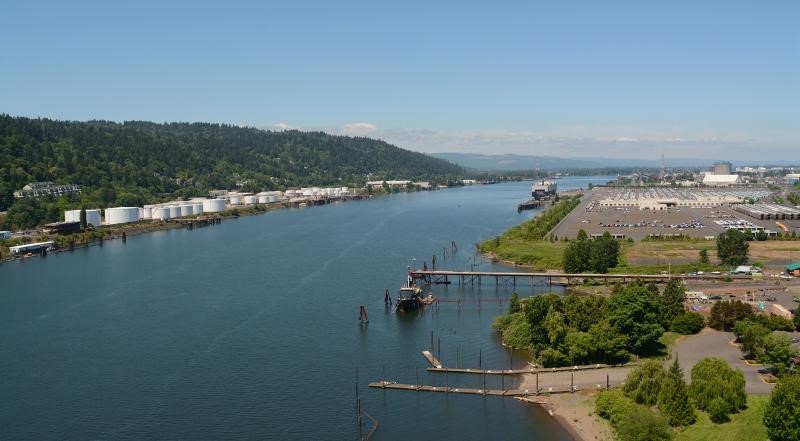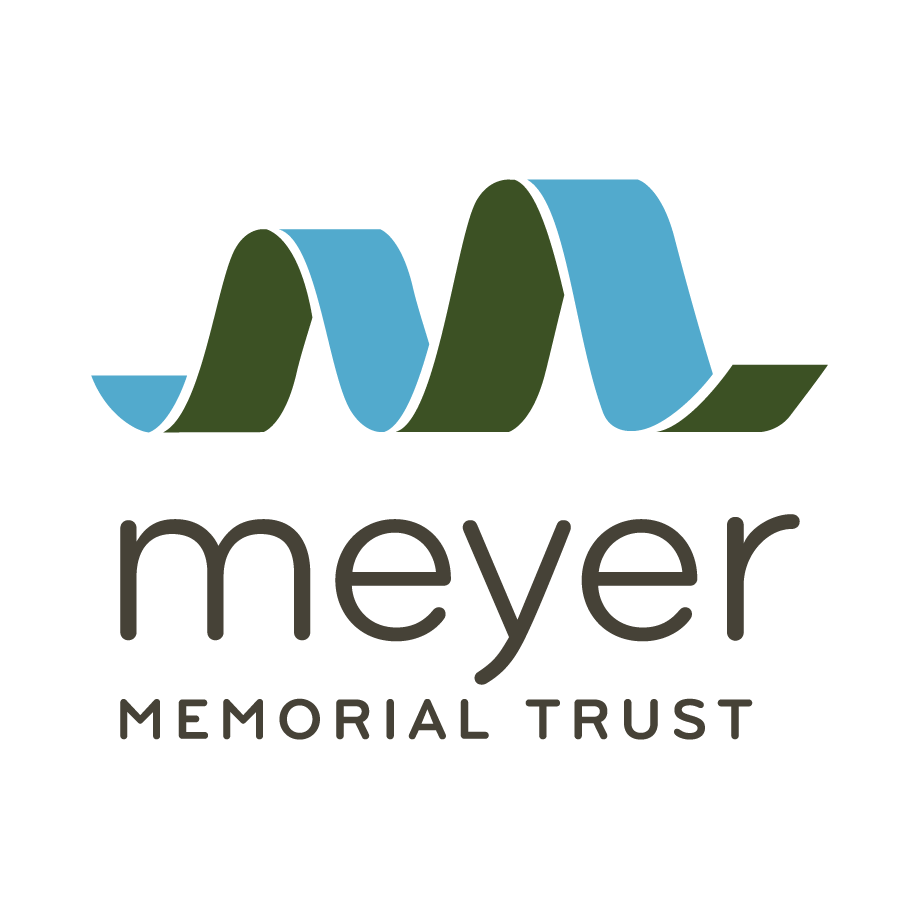The Willamette River has long sustained communities in the Pacific Northwest. Since time immemorial, Kalapuyan tribes have centered their livelihoods on its waters for fishing and on its fertile valley for agriculture. Today, two-thirds of Oregon’s population lives within an hour’s drive of the Willamette, and the river basin produces 75 percent of the state’s economic output.

But over the course of the past two centuries, this life-giving water has been exploited by colonization, polluted by industrial runoff, and encroached on by urbanization. Resident fish contain such high levels of polychlorinated biphenyl, a human-made chemical found in electrical equipment, that they are toxic to eat. Migrating fish such as salmon are edible, but they struggle to swim upstream due to the channelization of the river. Then there are the 13 federally owned dams, as well as private dams, that are used to control flooding and generate electricity but have impeded the river’s natural flow and fish’s migratory patterns.
Undoing this damage and repairing the health of the Willamette River has been an uphill battle, with individual organizations each trying to tackle different parts of the problem. This has been made even more challenging by the short-term funding for environmental work, which deters large-scale and long-term projects.
In 2008, Meyer Memorial Trust launched the Willamette River Initiative (WRI), in partnership with the Oregon Watershed Enhancement Board, to coordinate the efforts of disparate groups, build upon existing scientific research, and scale up ecological restoration across the river basin. The Bonneville Power Administration joined the initiative two years later, and the nonprofit Bonneville Environmental Foundation provided technical expertise, capacity building, and coordination to WRI grantees.
Over the course of 11 years, the partner organizations doled out more than $80 million, which grantees used to plant more than 3,900 acres of floodplain and riparian forest, reconnect 15.5 miles of side channels to the floodplain, remove or improve 23 barriers to fish passage, restore 18 miles of in-stream habitat, and enhance or treat 46 acres of wetlands. Overall, it was 15 times more restoration work than had been accomplished before the initiative began — and that’s just the work that can be represented through numbers.
According to the initiative’s partners and grant recipients, the unique success of the WRI is the collaboration it fostered across racial, ideological, and rural-urban divides, and the fruitful, ongoing relationships it created. Together these new networks are building people power to restore the Willamette River and communities’ relationships with it.
Connecting the basin through communication
In 1944, the lower Willamette, which runs through Portland, was labeled “biologically dead.” It wasn’t until 1972 that the river was deemed “biologically viable” again. Since then, river restoration groups have made meaningful efforts to address water quality and river health, but nearly all of the 187 miles of river still need restoration.
“Watershed councils tend to be fairly small, place-based organizations” that are tasked with the “Herculean job” of repairing large floodplains and developing sophisticated ecological projects, all while being accountable to the diverse needs of their community, explains Kathleen Guillozet, senior director of the watershed program at the Bonneville Environmental Foundation (BEF). “A lot of experiences, expertise, and challenges are highly transferable to other places, so the ability to share that is highly valuable.”
Through the Willamette River Initiative, BEF guided seven regional watershed councils through a model watershed program, in which the cohort met regularly, checked in on each other’s projects, and used each council’s unique skills to assist one another. The Calapooia-Santiam partnership, for example, is made up of three distinct watershed councils that share a single staff. The Calapooia Watershed Council houses the project managers, the North Santiam Council hosts the outreach coordinators, and the South Santiam Council provides the water quality monitoring staff. By leveraging each council’s specific skills, the 3-council partnership was able to initiate restoration projects in Stout Creek, Valentine Creek, and Bear Branch Creek during the model watershed program, partnering with more than 20 landowners to restore 75 acres of native vegetation and riparian forest.
“Before, we were all in our little silos,” says Rebecca McCoun, executive director of the North Santiam Watershed Council. “Meyer Memorial Trust and BEF staff helped kind of create this bird’s eye view, and then they connected people. The scope and scale of what we were able to accomplish was big because of that inter-management.”
Transforming landowners into land stewards
In the Southern Willamette Valley, three brothers are in the process of transforming their 320-acre family farm from an annual grass seed operation to a diversified orchard and ranch.

“A big part of what we wanted to do through our farming operations is not just grow food for people, but also provide clean drinking water and healthy habitat for things like fish and whatnot that live in that water,” says Taylor Larson, one of the three brothers that co-own My Brothers’ Farm.
To find out how their farmland could be best leveraged to support the local ecosystem, Larson and his brothers reached out to the Coast Fork Watershed Council and discovered their farm is an anchor habitat — an area along the Willamette River that is especially important for migratory native fish. Unfortunately, in the process of channelizing the river to prevent flooding in the early 1900s, the U.S. Army Corps of Engineers removed the riparian forest here — the plants located where the river meets the land, which provide food and shelter for wildlife.
My Brothers’ Farm and the Coast Fork Watershed Council received a WRI grant in 2017 to expand and advance the riparian forest on more than 70 acres of the farm along the Coast Fork Willamette River. When the project is completed in 2022, more than 160,000 native trees and shrubs will have been planted on My Brothers’ Farm. The plants provide leaf litter and other nutrients for wildlife. And once the trees grow large enough to shade the riverbanks, they will help cool the water, too, which is critical for migratory fish like salmon.
“The habitat restoration world is full of some amazing, passionate people who have a lot of expertise that I think sometimes is underutilized by people like me and other agricultural professionals who are managing landscape[s],” Larson says.
He notes that the WRI’s model of engagement and collaboration relies on a significant amount of upfront community-building work that can make projects seem slow. But building that foundation is critical to the integrity and longevity of ecological projects.
“When you want to go fast, go alone,” Larson says. “When you want to go far, go together.”
Challenging the dominant culture
As the river initiative was making connections and progress across the region, WRI leaders started to take stock of what community groups those collaborators represented — and didn’t. In 2015, to align with a new equity mission at Meyer Memorial Trust, the initiative developed a goal to advance diversity, equity, and inclusion within the larger Willamette restoration movement. This meant challenging the Euro-American, Western science-based assumptions the initiative was built upon — how river restoration was defined and implemented in the first place.
The WRI partnered with the Center for Diversity and the Environment, a Portland-based nonprofit that aims to bridge the racial divide in the environmental movement. The group guided white-led grantees through immersive retreats, webinars, and coaching sessions on how watershed restoration work can better address the racial disparities of who benefits from the investments in river restoration.
“The Willamette River Initiative had already been putting a lot of energy and effort and resources into environmental organizations that were primarily run and led by white folks, so this was an opportunity to pause and ask questions,” says Gladys Ruiz, who assessed and advised the WRI on culturally relevant and inclusive environmental education. “What we were trying to do was get these white-led organizations up to a certain level, but without acknowledging that there are organizations out there that are already doing this work that they don’t necessarily claim as environmental education.”
The rigid line between environmental and social causes, she says, is a product of the dominant white culture that values scientific metrics over the personal relationships to the environment that communities of color, particularly Indigenous communities, prioritize. That’s why Ruiz connected with environmental groups led by and for communities of color throughout the basin, including Mudbone Grown, a Black-owned farm that promotes community-based farming and education, and Huerto de la Familia, a nonprofit increasing the health and economic security of Oregon Latinos by providing organic agriculture training to families.
In order to decolonize the environmental movement, Ruiz says it is critical to develop spaces where organizations led by Black, Indigenous, and people of color (BIPOC) can develop relationships with each other, express their frustrations, and discuss their goals. Through the WRI, Ruiz created a space for a cohort of 11 environmental educators, organizers, and community stakeholders of color to do just that.
An inclusive ecology
The Portland Harbor Superfund Site is a 10-mile stretch of the Willamette River contaminated by 38 different toxic chemicals, including a wide range of pesticides, combustion byproducts, and industrial chemicals. The site downriver from downtown Portland was designated by the EPA in 2000, but by the 2010s, cleanup was still slow going and community members saw concerning patterns of exclusion of diverse voices.

So in 2012, the Portland Harbor Community Coalition (PHCC) formed to ensure representation of the communities disproportionately impacted by river pollution: Indigenous populations who have been removed from their land and no longer have access to reliably edible fish; Black families who moved from the South to work in the Portland Harbor during WWII and were exposed to toxic pollution; and people experiencing homelessness, who often rest near and fish in the river.
“We have seen the effects on our lives,” says PHCC steering committee member Wilma Alcock, whose family moved from Oklahoma to Portland in the early 1940s because her father found work in the shipyard prepping boats for WWII. “Data can only tell you about a certain percentage of what is happening. But when people have been personally involved, they can tell you exactly what’s happening or how it’s happened to them. It’s more than just the pollution of the river; it’s pollution of the people.”
Around this time, the WRI recognized that limiting its funding to the upper basin, the original focus of the initiative, excluded Portland and the opportunity to address the disparate impacts of poor river health on some of the valley’s most vulnerable populations. So, the WRI began helping fund the coalition’s work to organize public comments during the development of the EPA’s proposed Superfund clean-up plan in 2016, garnering 5,300 statements from the community. Their advocacy resulted in a public involvement program within the Bureau of Environmental Services, as well as the placement of two PHCC members on the Superfund proposal evaluation committee.
“What’s necessary when you’re up against the bureaucracy of the Superfund, or legacy contamination issues, and dealing with the power of polluters and their lawyers and their money, is to build people power,” says Cassie Cohen, PHCC’s executive director. “The only way we’re able to do anything is through collectively organizing and building a base that is holding all of those parties accountable.”
Resilient partnerships
Building strong relationships that harness people power takes time, so as the WRI’s 10-year funding stream came to a close in 2019, grantees renewed their commitment to collaborate. Five of the seven watershed councils from the model watershed program developed the Mid-Valley River Connections, which replicates the resource-sharing aspects of the WRI program with a specific emphasis on seeing the health of human communities and the river as intertwined. The group has since launched projects like the Mid-Willamette Beaver Partnership — an effort to restore beaver habitats, and thus beaver populations, across four counties.
Meyer is now providing startup funding for the Willamette River Network, a community-led group made up of WRI partners who intend to continue and expand the work of the initiative.
“We’re here to create connections and build community, and then also look at sharing and leveraging resources to build capacity,” says Tana Atchley Culbertson, the Willamette River Network’s director of network coordination.
Network staff is building on the foundation developed through the WRI by reaching out to environmental justice groups across the basin, holding quarterly convenings for network participants, and connecting philanthropic funders to restoration projects. Culbertson emphasized the importance of centering Indigenous-led organizations and communities in river restoration work, which is why the network is changing its name to Nesika Wilamut in May. The new name means “Our Willamette” in Chinuk Wawa, a language based on Chinookan (with some influence from French and English) that was developed between the Native people and traders along the Willamette and Columbia Rivers to conduct commerce and collaborate. To network leaders, the name change isn’t simply symbolic; it represents the group’s core values.
“To be effective and carry forward this work, we needed to engage a broader and diverse array of groups, organizations, and individuals, and really knit them together with others so that this work could increasingly become more equitable,” says Jesse Cruz Richards, director of development and policy for the network. “We’re very much calling on the environmental community in the Pacific Northwest to take a reparative turn towards Indigenous communities and center their voices and their knowledge in the work that we all as a human race need to do right now.”
Meyer Memorial Trust, established in 1982, is among the largest private foundations in Oregon. Over its lifetime, Meyer has awarded grants and program related investments in excess of $840 million to more than 3,650 organizations. Today, Meyer focuses on work in Oregon dismantling barriers to equity in education, housing and the environment and improving community conditions so that all Oregonians can reach their full potential. Learn more about Meyer’s efforts to make Oregon a flourishing and equitable state at mmt.org.




